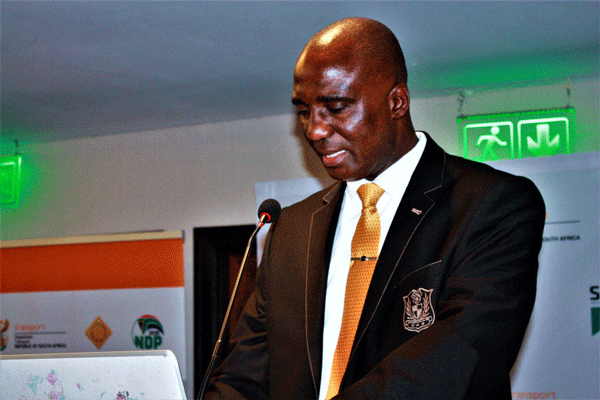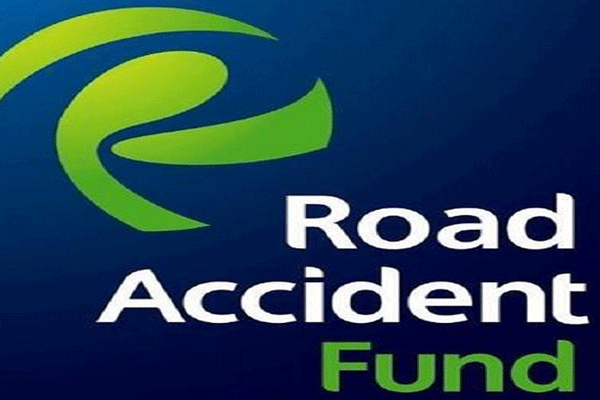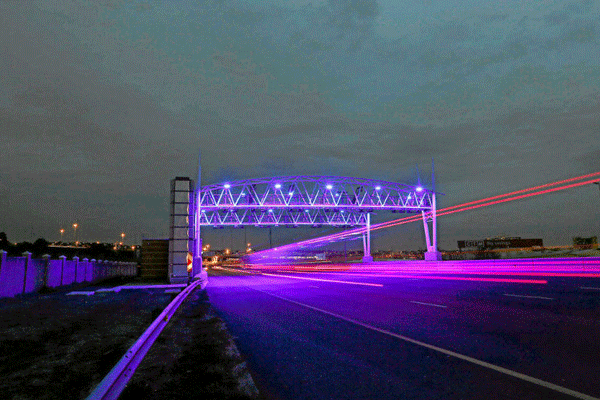Stakeholders in construction and related industries met SANRAL in 34 workshops in more than 30
cities and towns across the country. Here individuals, companies and organisations that might be
affected by SANRAL’s new direction discussed their future roles and contributions. These sessions
were based on the road agency’s long-term vision, Horizon 2030 and its draft transformation policy.
Blog
Youth employment boost
SANRAL and its construction partners teamed up at a cost of R1.4m to address the youth
unemployment crisis in Malmesbury, which is on the N7. 22 learners received certificates for
completing NQF Level 3 and 10 for NQF Level 4. These were all focused on various construction
disciplines.
N2 Wild Coast road project update
The four haul roads for the N2 West Coast Road Project are close to completion. They will facilitate
the movement of materials, equipment, machinery and workers to the Msikaba and Mtentu bridge
projects. They are essential support structures for these major bridges which require specialised
engineering skills and building techniques.
Moloto Rd project update
All construction on the R573 Moloto Road is shut down for the December holidays but will resume on
8 January 2018. Routine road maintenance work went on uninterrupted. The road will be open to
traffic during the shut-down period. Progress on the upgrade is on schedule.
Extended guarantee for SANRAL
Investment in infrastructure and the good governance of state-owned entities were recurring themes
in the Medium Term Budget delivered in Parliament at the end of October by the Minister of Finance,
Malusi Gigaba.
The extended policy statement released with the speech emphasises that “difficult trade-offs will need
to be made” to avoid a deterioration in the national road network should government decide not to use
tolling as a funding mechanism for major freeways.
Mr Gigaba focused on the important role played by state-owned companies, which he described as
“powerful levers for the state to directly drive economic transformation.” They have played a leading
role in the development of world-class infrastructure which sustains the South African economy.
However, government as the shareholder is also “tired of being dragged into crises” at entities and will
no longer provide bailouts to finance operational expenditure, inefficiency and waste, he said.
The Budget Statement notes that SANRAL has been provided with an extended guarantee of
R38.9bn to expand its toll roads portfolio. In response to public concerns about electronic tolling in
Gauteng, SANRAL introduced a lower-cost dispensation. However, collections remain lower than
projected, making it difficult for the agency to service its debt.
Government has clarified the conditions of the SANRAL guarantee. This gives SANRAL more room to
borrow under the guarantee and allows the agency to service all its commitments over the medium
term.
Over the longer term, an improvement in toll revenue collection is needed to ensure SANRAL’s
sustainability. If government does not proceed with tolling to fund major freeways, difficult trade-offs
will have to be made to avoid a deterioration in the national road network.
Issues to note:
1. Transport and logistics are at the core of the implementation of the National Development
Plan. Reforms will be introduced to drive down port and rail prices, improve global
competitiveness and boost the tourism sector, which is a critical source of revenue.
2. Changes to government’s procurement policies are already yielding results. This includes
targeted procurement from SMMEs and designated groups such as black youth, women,
township and rural enterprises.
3. Supply chain reform is working. The introduction of expenditure ceilings and cost containment
measures in the public sector has already led to savings of more than R2bn. The fight against
abuse of the supply chain management system is being extended to cover both public and private
sector corruption.
4. Spending on infrastructure will grow rapidly. The lion’s share of infrastructure is provided by
state-owned entities – R403bn over the next three years. A new approach will focus on the
maintenance of existing infrastructure, improved procurement and better conditional grants to
eliminate inefficiencies and underspending.
Road safety is everyone’s responsibility
Government has partnered with community safety councils in every province to bolster its efforts to reduce road accidents.

Collaboration between communities and government is needed to tackle the issues of road safety.
With this in mind, government has partnered with community safety councils in every province to bolster efforts to reduce road accidents.
It was the job of government “to empower communities as masters and shapers of their own destiny to identify local road safety challenges and then address those with [the safety councils]”, said Minister of Transport Joe Maswanganyi at the launch in Bela-Bela, Limpopo, of the Department of Transport’s festive season road safety campaign. “Our people … are the ones who must deal with these [issues] daily.”
Road safety challenges were societal problems, he added. “We need to collaborate and work closely with our provinces, municipalities and communities if we are to win this battle.”
Statistics indicate that most people who die on the roads are young people aged between 20 and 34, according to the Department of Transport.
“Due to their energy and militancy, young people are always at the forefront of change. We should, as leaders of society, allow space for these young people, through their organised formations, to play a role in addressing the scourge of road deaths that so badly affects them,” said Minister Maswanganyi.
Hlokomela-Phila campaign
In addition to the road safety campaign, the Department of Transport has launched the Hlokomela-Phila campaign in partnership with the South African National Taxi Council and the Department of Health.
The campaign aims to improve health and wellness within the taxi industry. Operators, drivers, commuters, street traders and other key players in the sector will be offered HIV testing services, as well as screenings for TB and non-communicable diseases.
Stakeholders in the sector will be able to test for diabetes and hypertension at taxi ranks and transport hubs across the country.
The minister called on everyone to work together to make this year’s festive season a different and memorable one.
“I have no doubt that we shall emerge from this festive season firmer and more resolute in our determination to turn the tide against the carnage on our roads,” he said.
Minister talks tough on reckless driving
Traffic authorities will have a zero-tolerance approach to law enforcement over the festive period in an effort to reduce fatalities.

Statistics show that South African road and traffic officials have a monumental task to improve the behaviour of road users, according Minister of Transport Joe Maswanganyi.
The number of deaths on the country’s roads during the festive season over the past three years – from 1 587 in 2014/15 to 2 006 in 2016/17 – shows a need for a zero-tolerance approach to law enforcement on the road, the minister added.
Minister Maswanganyi was speaking at the launch of the Department of Transport’s festive season campaign in Bela-Bela, Limpopo.
Five provinces, the Eastern Cape, KwaZulu-Natal, Gauteng, Limpopo and Mpumalanga, accounted for 73% of all fatalities last year.
This festive season, government will strive to combat this by removing unfit drivers and vehicles from the road. “Those that do not adhere to the standards [expected of road users] will not leave the provinces of their origin. Residential areas such as suburban, township and village roads will be policed to ensure that holidaymakers do not cause unnecessary crashes,” Maswanganyi said.
Back to basics
A trends analysis of festive season road crashes showed that over the past three years, road accidents spiked over weekends, according to the Department of Transport.
Many of the accidents take between 3pm and mid-night, and between 4am and 7am.
“I would like to make a clarion call for us get back to basics and direct our efforts at high risk violations occurring at certain times and places that lead to an increased number of accidents,” Maswanganyi said.
The situation is compounded on long weekends where alcohol consumption spikes, leading to reckless and negligent driving, a bold disregard of road rules and an increase in road crashes, injuries and fatalities.
The minister condemned acts of criminality, such as motorists bribing officers of the law.
Remembering fallen heroes
He used the launch to remember officials who died on duty because of the negligence of some drivers.
“I urge all motorists to treat our traffic officers with respect and dignity. Let us all bear in mind that traffic officers have chosen this career to serve and protect the nation against lawlessness.”
He warned motorists and the public that an attack against law enforcement officers was an attack against the State and would not be tolerated. “Those who attack them must be pursued, arrested and face the full might of the law.”
Minister Maswanganyi urged municipalities and provincial authorities to ensure adequate protection of traffic officers.
Road Accident Fund: All you need to know
People involved in road accidents are urged to claim directly from the Road Accident Fund instead of spending large amounts of money on litigation fees.

Anyone injured in a road accident is encouraged to claim compensation directly from the Road Accident Fund (RAF) rather than spending money on litigation.
“Using lawyers can be costly and often results in a large chunk of the money intended for the victim being spent on litigation fees instead of their maintenance,” said Minister of Transport Joe Maswanganyi.
He was speaking at the launch of the Department of Transport’s festive season campaign in Bela-Bela, in Limpopo.
Beneficiary speaks
The minister handed over a wheelchair to Letlhogonolo Chokwe, a RAF beneficiary who, as a pedestrian, was hit by a car in 1989.
“They [the RAF] have really assisted me with compensation; everything I need, like the wheelchair, crutches and the chair I use in the shower, they bought for me. Whenever I need help, they assist me,” said Chokwe.
The RAF, an agency established by the Road Accident Fund Act of 1996, provides appropriate cover to all road users within the borders of South Africa. It pays medical and rehabilitation costs as well as compensation to people injured as a result of motor vehicles accidents.
RAF officials are available all over the country and are also strategically placed in hospitals to assist those who involved in road accidents.
“You often find that we, as [the Department of Transport], have to go through lengthy court processes to ensure beneficiaries receive their money when they make use of a lawyer,” said Maswanganyi.
The efficiency of RAF is, therefore, a crucial component to deliver services to all road users.
“We are grateful that the Road Accident Fund is improving its administration of funds to the beneficiaries,” the minister said.
Steps to claim
The first step in claiming from the RAF is to gather all the necessary documents:
- The police report and case number of the accident.
- All your relevant personal details as well as those of any other person involved in the accident.
- All medical documents supporting the claim for the injuries incurred.
- Any motivating testimony from medical and/or legal experts, as well as witness testimony.
- Any relevant information pertaining to the accident such as damages to the vehicle/s and/or surrounding structures.
Make sure all the official RAF forms are filled in.
Who may make a claim?
Claims may be made by:
- A person who sustained a physical injury in the accident – except for a driver who was the sole cause of the accident.
- A dependent of a deceased breadwinner.
- A close relative of the deceased who paid for the funeral.
A claimant under the age of 18 years must be assisted by a parent, legal guardian or curator ad litem.
- In addition, claims can be submitted by the injured person or a representative and/or the supplier in terms of a certificate of undertaking.
- In the event of the supplier making a claim, a written request is required before the assessed liability can be reimbursed.
What is the time period in which a person can claim?
- Identified claims (where the identity of the driver or owner of the motor vehicle involved is known) must be lodged with the RAF within three years from the date of the accident and must be finalised within five years from the date of accident.
- Hit and run claims (where the identity of the driver or owner of the motor vehicle involved is unknown) must be lodged with the RAF within two years from the date of the accident and must be finalised within five years from the date of accident.
- Claims in terms of the undertaking certificate issued in terms of section 17(4)(a)(ii) of the Act must be lodged and finalised within five years from the date on which services were rendered to the injured.
For more information, go to https://www.raf.co.za/Pages/default.aspx.
National road network at core of local growth
The national road network has been growing over the years, and this improves connectivity between cities and regional hubs.

It is important to unlock the value of South Africa’s road network and build partnerships with communities along these routes so they can benefit economically from their local roads.
“At a time when the world is undergoing rapid changes brought on by new – and sometimes disruptive – technologies, it is important for 21st century organisations such as SANRAL to embrace change and continuously adapt strategies to remain at the leading edge of trends in the management of vital economic infrastructure,” said the general manager of communications at The South African National Road Agency (SOC) Limited (SANRAL), Vusi Mona.
The national road network has been steadily growing over the years, improving connectivity between cities and regional hubs. It is via the road networks that the majority of South African citizens commute and conduct business.
Against this background, it is critically important to unlock the value of South Africa’s road network and to build partnerships with communities so that these communities can become active participants in the entire process of delivery, which includes planning, construction, as well as the supply of services and material to long-term maintenance of local roads, Mona said.
Embracing innovation
An important aspect of an ever-changing world is the challenge brought about by rapidly evolving Smart Road Technologies and global innovation.
“Innovating to create a better and safer road network can never operate in isolation, and SANRAL has always been acutely aware of, and committed to, impacting positively on the lives of the communities in which it operates, across the national road network,” Mona said.
He was particularly excited that innovation funding had been prioritised through the establishment of the Western Cape-based Technical Innovation Hub (TIH) during the 2016/17 financial year.
The TIH, he said, could be likened to a think tank of young intellectuals, who were mentored by senior professional engineers, and who could be inspired by the possibilities that exist when technology is harnessed to improve South African lives and promote progressive development in transport.
Simply creating road infrastructure was not enough when citizens did not always have the ability and resources to access developmental opportunities created by an improved road network, he said.
To this end, SANRAL’s Community Development Programme was a way of strengthening communities, particularly those who were adjacent to the national road network.
The programme addressed both concrete and intangible human needs, Mona added.
“SANRAL implements a detailed plan when working with community structures on all of its projects, with the goal of providing improved access and mobility in a locally sensitive manner, and offering opportunities for economic empowerment.”
Future focus
With SANRAL having had two decades as the custodian of the South African road network, Mona is pleased to note that the length of the network has tripled from 6 700 km in 1998 to the current 22 000 km – with an estimated net asset value of more than R250-billion.
“We stand at the start of a global new era in transportation technology, where concepts such as smart roads, intelligent infrastructure and driverless vehicles have moved from the realms of science fiction to a future that is just down the road.”
SANRAL’s medium-term strategy, named Horizon 2030, aligns with the timeframes set in the National Development Plan.
Horizon 2030 is a proactive response to deliver on SANRAL’s vision of a national transport system that builds South Africa through better roads, Mona said.
Two examples of the agency’s ongoing investment in the long-term future of South Africa’s road network can be seen in the R3.2-billion invested in the upgrade of the N7 corridor and the construction of two mega bridges as part of SANRAL’s N2 Wild Coast road project in the Eastern Cape.
“We are looking forward to continuing to engage with other role players in the construction and engineering sectors, with our sister agencies and road authorities, with provincial and national departments, and with the experts in our various engineering disciplines, as we strive to build South Africa through better roads,” he added.
World Road Association Conference
In October 2017, SANRAL hosted engineers from several countries at the biannual World Road Association (PIARC) conference on Road Tunnel Operations in Low and Medium-Income Countries. The event was formally opened by SANRAL CEO Skhumbuzo Macozoma.
“The biannual seminar was an opportunity to draw on knowledge and technical leadership from over 30 governments globally, and was, in itself, a huge benefit to growing the knowledge economy within South Africa,” said Mona.
During the conference, engineering professionals engaged with thought-provoking presentations on new technological breakthroughs in civil engineering around safe design and operations of road tunnels.
The South African team led with a presentation on the Huguenot Tunnel, a major transportation link between the Western Cape coast and the interior. The presentation looked at operations, maintenance and planned upgrades.
Single account eases passage through national toll plazas
Drivers using the automated electronic payment system on the country’s toll roads will enjoy the benefits of an uninterrupted traffic flow and shorter travel times this festive season.

Road users on South Africa’s toll road network will continue to enjoy the benefits of an automated electronic payment system during this holiday period.
The fully interoperable tag system, introduced by the South African National Roads Agency (SOC) Limited (SANRAL) in 2015, has proven to be a major success.
The same tag can be used at toll plazas operated by SANRAL and its concessionaires, Bakwena Toll Concessionaires, N3 Toll Concessions (N3TC) and Trans Africa Concessionaires (TAC).
Road users can register a single account and use a tag, linked to the account, for all the toll plazas – irrespective of who operates the plaza.
“We are very pleased with the growth and take up of electronic toll transactions across all historical ‘manually’ operated toll plazas in South Africa,” said manager of toll and traffic at SANRAL, Alex van Niekerk.
“The average number of toll transactions done electronically has grown from a zero base to above 20% in quantum and 30% in value over the past two years.”
Improved service and delivery
The transition from manual to electronic toll systems is aligned with the expectation road users have for improved service and efficiency: drivers do not want to delay their journeys when paying at a conventional toll facility.
A system of electronic toll collection has been developed over the last decade, allowing road users to move through toll plazas without delay.
Automated electronic toll payment is an efficient, fair and sustainable method of collecting tolls. Among its benefits are improved speed and efficiency of traffic flow for the convenience of road users and a reduction the overall journey time due to less time spent making toll payments.
Travel information
Some important information for those travelling this festive season:
- For a detailed list of toll plazas where automated electronic toll payment will be accepted, visit the SANRAL website sanral.co.za/e-toll.
- Signs at the plaza will indicate which lane can be used to pay with a tag.
- If a ‘tag accepted’ sign is displayed at the toll plaza and lanes are not individually marked, it means all lanes accept tags:
- reduce speed when entering the toll plaza area;
- select a lane which accepts SANRAL tags as a method of payment; and
- maintain a car-length following distance to avoid paying for the vehicle in front.
- If a tag is detected, it will emit one or more beeps depending on the account status:
- 1 beep – payment successful;
- 2 beeps – low balance warning; and
- 4 beeps – account suspended because there are no funds in the account.
- Ensure there are sufficient funds on the tag to accommodate the costs of all toll plazas en route.
- Note that payments made into the toll account may take up to five days to reflect, if they have not been made online (sanral.co.za/e-toll) or at a SANRAL Customer Service Centre. Booms will not open if the funds in the toll account are less than the amount due at the specific toll plaza. It is possible to create an automated top-up on the account by linking it to a conventional bank account or credit card.
- Keep all till slips safe should there be any disputes at a later stage, for example, in the event of double billing, when the tag appears not to have been read and cash is paid.
“Should any motorist need help in planning their journey, contact our Customer Services on 0800 726 725, visit one of our centres or email us on info@sa-etoll.co.za,” said Van Niekerk.

